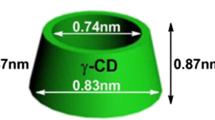Abstract
Caffeic acid (CA) is a hydrophobic polyphenol with a high antioxidant capacity and γ-cyclodextrin (γ-CD) is a cyclic polysaccharide. The current study prepared a coprecipitate (CP), a freeze-dried (FD) preparation, a ground mixture (GM), and a physical mixture (PM) of CA and γ-CD, and this study then assessed the physicochemical properties and antioxidant capacity of these preparations. PXRD patterns revealed that a PM and a GM prepared at a certain molar ratio (CA/γ-CD = 1/1) produced a diffraction peak due to CA crystals. Diffractions peaks characteristic of CA and γ-CD disappeared with the CP, but new peaks were noted. In addition, an FD with CA and γ-CD at a molar ratio of 1/1 produced a halo pattern. DSC measurements revealed that the PM produced an endothermic peak at 220 °C due to the melting of CA, but the endothermic peak due to CA disappeared with the CP, FD, and GM. IR spectra revealed that the absorption peak due to the carbonyl group (C=O) of CA shifted for both the CP and the FD. The absorption peak due to C=C in the aromatic ring of CA also shifted. These findings presumably indicate molecular interaction between CA and γ-CD when the 2 substances are present at a molar ratio of 1/1 (CA/γ-CD). In the GM, molecular interaction presumably occurred as a result of heat. The preparations were compared to CA alone in dissolution testing, which revealed that the CP and FD both had a high rate of dissolution. 1H-1H NMR (NOESY) spectra revealed cross peaks involving protons of the γ-CD cavity and protons of the aromatic ring of CA. Thus, the formation of CA and γ-CD inclusion complexes helped to improve the dissolution of CA and γ-CD at a molar ratio of 1/1. The CP and FD had a higher antioxidant capacity than did CA alone. This presumably indicates that the formation of CA and γ-CD inclusion complexes helped to increase the electron density of CA in the CD cavity.











Similar content being viewed by others
References
Christian, E., Thomas, J.D., Susanne, W., Felix, L., Florian, B., Nadine, W., Maani, H., Dittmar, B., Hugo, A.K., Christian, A.G.: Expression of IL-17A in human atherosclerotic lesions is associated with increased inflammation and plaque vulnerability. Basic Res. Cardiol. 106, 125–134 (2011)
Khushwant, S.B., Grégoire, L., Mohamed, T., Vasantha, R.: Antihypertensive effect of caffeic acid and its analogs through dual renin-angiotensin-aldosterone system inhibition. Eur. J. Pharmacol. 730, 125–132 (2014)
Jiang, H.C., Chi-Tang, H.: Antioxidant activities of caffeic acid and its related hydroxycinnamic acid compounds. J. Agric. Food Chem. 45, 2374–2378 (1997)
Monika, M., Stefanie, H., Alois, J.: Anti-inflammatory activity of extracts from fruits, herbs and spices. Food Chem. 122, 987–996 (2010)
Casciari, J.J., Riordan, N.H., Schmidt, T.L., Meng, X.L., Jackson, J.A., Riordan, H.D.: Cytotoxicity of ascorbate, lipoic acid, and other antioxidants in hollow fibre in vitro tumours. Br. J. Cancer. 84, 1544–1550 (2001)
Marcus, E.B., Thorsteinn, L.: Cyclodextrins as pharmaceutical solubilizers. Adv. Drug Deliv. Rev. 59, 645–666 (2007)
Tao, T., Yan, Z., Jinjin, W., Beiyi, Z.: Preparation and evaluation of itraconazole dihydrochloride for the solubility and dissolution rate enhancement. Int. J. Pharm. 367, 109–114 (2009)
Mohsen, A., Khalid, A., Abdulaziz, A.: Effect of inclusion complexation with cyclodextrins on photostability of nifedipine in solid state. Int. J. Pharm. 243, 107–117 (2002)
Arumugam, S.P., Jeyachandran, S., Baskaralingam, V., Thambusamy, S.: Improvement on dissolution rate of inclusion complex of Rifabutin drug with β-cyclodextrin. Int. J. Biol. Macromol. 62, 472–480 (2013)
Claudia, G., Ana, K.C., Marcela, L.: Improving furosemide polymorphs properties through supramolecular complexes of β-cyclodextrin. J. Pharm. Biomed. Anal. 95, 139–145 (2014)
Yutaka, I., Noritaka, I., Etsuo, Y., Toshio, O., Kenjirou, H., Kunikazu, M., Keiji, Y.: Solid states fluorescence study of p-dimethylaminobenzonitorile by co-grinding with cyclodextrins. Yakugaku Zasshi 129, 253–262 (2009)
Erika, S., King, W.L., Madeleine, D., Florent, C., Kawthar, B.: Dehydration, dissolution, and melting of cyclodextrin crystals. J. Phys. Chem. B. 119, 1433–1442 (2015)
Tarja, T., Teemu, H., Jukka, L., Laura, M., Sitaram, V., Pekka, J., Johan, C., Vesa-Pekka, L., Tomi, J., Kristiina, J.: Crystal structure changes of γ-cyclodextrin after the SEDS processing supercritical carbon dioxide affect the dissolution rate of complexed budesonide. Pharm. Res. 24, 1058–1066 (2007)
Marcus, E.B., Thorsteinn, L.: Cyclodextrins as pharmaceutical solubilizers. Adv. Drug Deliv. Rev. 59, 645–666 (2007)
Lajos, S., Jozsef, S.: Cyclodextrins as food ingredients. Trends Food Sci. Tech. 15, 137–142 (2004)
Ju, Y.F., Hui, L.C., Doryn, M.Y.T., Kim, T.T.: Bioavailability of tocotrienols: evidence in human studies. Nutr. Metab. 11, 1–10 (2014)
Jianbin, C., Hongfang, W., Wei, Z., Min, Z., Liwei, Z.: Investigation of the inclusion behavior of chlorogenic acid with hydroxypropyl-β-cyclodextrin. Int. J. Biol. Macromol. 50, 277–282 (2012)
Kenjirou, H., Saori, I., Haruka, W., Kunikazu, M., Keiji, Y.: Incorporation of salicylic acid molecules into the intermolecular spaces of γ-cyclodextrin-polypseudorotaxane. Cryst. Growth Des. 9, 4243–4246 (2009)
Zingone, G., Rubessa, F.: Preformulation study of the inclusion complex warfarin-β-cyclodextrin. Int. J. Pharm. 291, 3–10 (2005)
Yan, X., Hong, Y.P., Meng, X.Z., Xia, L., Wei, W.Z., Xiao, E.Y.: Caffeic acid product from the highly copper-tolerant plant Elsholtzia splendens post-phytoremediation: its extraction, purification, and identification. J. Zhejiang Univ. Sci. B. 13, 487–493 (2012)
Samikannu, P., Krishnamurty, S., Meenakshisundaram, S., Rajaram, R.: Preparation and characterization of host–guest system between inosine and b-cyclodextrin through inclusion mode. Spectrochim Acta. A. Mol. Biomol. Spectrosc. 147, 151–157 (2015)
Acknowledgments
The authors wish to thank Cyclo Chem Co. Ltd. for providing γ-CD.
Author information
Authors and Affiliations
Corresponding author
Ethics declarations
Conflicts of interest
The authors declare no conflicts of interest.
Rights and permissions
About this article
Cite this article
Inoue, Y., Suzuki, K., Ezawa, T. et al. Examination of the physicochemical properties of caffeic acid complexed with γ-cyclodextrin. J Incl Phenom Macrocycl Chem 83, 289–298 (2015). https://doi.org/10.1007/s10847-015-0564-1
Received:
Accepted:
Published:
Issue Date:
DOI: https://doi.org/10.1007/s10847-015-0564-1




